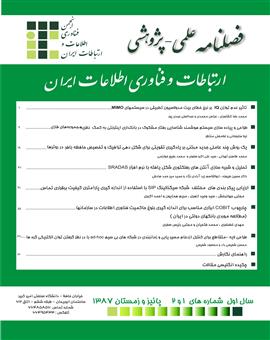محاسبه سريع انتگرالهای تشعشعی با روش FFT جهت کاربرد در تحليل آنتنهای بازتابنده شکليافته
محورهای موضوعی :ذاكر حسين فيروزه 1 , ابوالقاسم زيدآبادي نژاد 2 , حميد ميرمحمد صادقي 3
1 - دانشگاه صنعتي اصفهان
2 - دانشگاه صنعتی اصفهان
3 - دانشگاه صنعتي اصفهان
کلید واژه: آنتنهاي بازتابنده, انتگرالهاي تشعشعي, FFT,
چکیده مقاله :
در اين مقاله، روشی سريع برای محاسبه پترن تشعشعی ميدان دور آنتنهای بازتابنده با تحريک دلخواه در محل تغذيه ارائه میگردد. آنتن بازتابنده با روش نور هندسی GO تحليل شده، سپس ميدانهای تشعشعی با روش ميدان دريچه AFM بدست آمده و انتگرالهای تشعشعی با تبديل فوريه دوبعدی FFT مبتنی بر مشبندی بهينه دريچه محاسبه میشوند. براساس روش ارائه شده، نرمافزاري مبتنی بر MATLAB طراحي و پيادهسازي شده است که قابليت شبيهسازي آنتنهاي بازتابنده شكليافته با ابعاد بزرگ نسبت به طول موج و تغذيه جابجا شده از کانون را دارد. به عنوان نمونه، دو آنتن مورد استفاده در صنايع نظامی از جمله آنتن رادار مراقبت هوايی و رادار تاكتيكي TPS-43 تحليل شده و با نتايج شبيهسازی حاصل از نرمافزار FEKO و اندازهگيری مقايسه شده است. اين روش در عين سادگی، سرعت و دقت مناسبی در تحليل آنتنهاي بازتابنده شکليافته دارد. لذا نرمافزار حاصل در طراحی آنتنهای بازتابنده با تغذيه جابجا شده، میتواند يک ابزار مناسب جهت تعيين اوليه کارآيی آنتن و مشخصات تشعشعی موردنياز باشد و در صورت حصول پارامترهای طراحی موردنظر، شبيهسازی دقيقتر با نرمافزارهايی نظير FEKO يا NEC انجام شود و بدين صورت زمان موردنياز در روند طراحی کمتر شود.
A rapid calculation method of the far-field radiation patterns of a shaped reflector antenna illuminated by a feed in an arbitrary location is reported. In this method, the equations of geometrical optics (GO) are used to calculate the reflected electric field using the radiation patterns of the feed and the parameters defining the reflector surface. These fields comprise the aperture field distribution which is integrated over the aperture plane by Fast Fourier Transform (FFT) algorithm based on low-size meshing of the aperture to yield the far-field radiation patterns and to calculate other antenna parameters. Shaped Reflector Antenna Design and Analysis Software (SRADAS) based on this numerical method can analyze and simulate all shaped reflector antennas with large dimensions in regard to the wavelength. SRADAS has been implemented and used in Information and Communication Technology Institute (ICTI) to analyze and simulate different practical parabolic and shaped reflector antennas. In order to confirm the integrity of the proposed calculation method, two practical antennas are analyzed using this software. The results are in good agreement with the results obtained by commercial software (Method of Moment) and measurement. Large shaped reflector antennas can be simulated by SRADAS fast and accurately.
[1] Skolnik, M. I., Radar Handbook, 2nd ed, McGraw-Hill, New York, 1990.
[2] Chu, T. S. and R. H. Turrin, "Depolarization properties of offset reflector antennas," IEEE Trans. Antennas & Propagation, Vol. 21, May 1973
[3] Rudge, A. W., "Offset reflector antennas with offset feeds," Electronic Letters, 611-613, Nov. 1973.
[4] Janken, J. A., W. J. English and D. F. DiFonzo, "Radiation from multimode reflector antennas," G-AP Symp. Digest, 306-309, 1973.
[5] Ingerson, P.G. and W. C. Wong, “Focal region characteristics of offset fed reflectors,” IEEE/AP-S Symp. Program & Digest, 121-123, June 1974.
[6] Karimkashi, S. and J. Rashed-Mohassel, "Sidelobe level reduction in symmetric dual-reflector antennas using a small lens antenna", J. of Electromagn. Waves and Appl., Vol. 20, No. 13, 1807–1816, 2006.
[7] Tian, Y., Y. H. Zhang and Y. Fan," The analysis of mutual coupling between paraboloid antennas," J. of Electromagn. Waves and Appl., Vol. 21, No. 9, 1191–1203, 2007.
[8] Rusch, W. V. T. and P. D. Potter, Analysis of Reflector Antennas, New York, Academic Press, New York, 1970.
[9] Kauffman, J. F., W. F. Croswell, and L. J. Jowers, "Analysis of the radiation patterns of reflector antennas," IEEE Trans. Antennas & Propagation, Vol. 24, 53-65, Jan. 1976.
[10] Love, A. W., Reflector Antennas, John Wiley & Sons, 1978.
[11] Kouyoumjian, R.G. and P. H. Pathak, "A uniform geometrical theory of diffraction for an edge in a perfectly conducting surface," Proceedings of the IEEE, Vol. 62, No. 11, 1448-1461, Nov. 1974.
[12] Lashab, M., C. Zebiri and F. Benabdelaziz, "Wavelet-based moment method and physical optics use on large reflector antennas," Progress In Electromagnetics Research M, Vol. 2, 189–200, 2008.
[13] Lashab, M., F. Benabdelaziz and C. Zebiri, "Analysis of electromagnetic scattering from reflector and cylindrical antennas using wavelet-based moment method," Progress In Electromagnetics Research, PIER 76, 357–368, 2007.
[14] Herzberg, Thomas, Rodica Ramer and Stuart Hay, "Antenna analysis using wavelet representations," Progress In Electromagnetics
Research Symposium 2005, Hangzhou, China, August 22-26.
[15] Galindo-Israel, V. and R. Mittra, “A new series representation for the radiation integral with application to reflector antennas,” IEEE Trans. Antennas & Propagation, Vol. 25, No. 5, 631-641, Sept. 1977.
[16] Balanis, C. A., Antenna Theory, Anlaysis and Design, John Wiley & Sons, 1982.
[17] Bracewell, R. N., The Fourier Transform and Its Applications, 2nd ed., McGraw-Hill, New York, 1986.
[18] Stutzman, W. L. and G. A. Thiele, Antenna Theory and Design, 2nd ed., John Wiley & Sons, 1997.


